
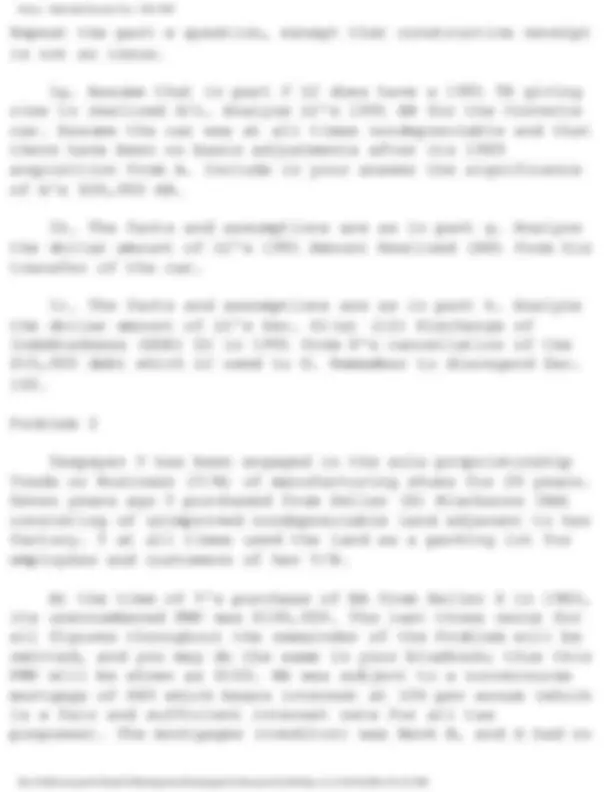
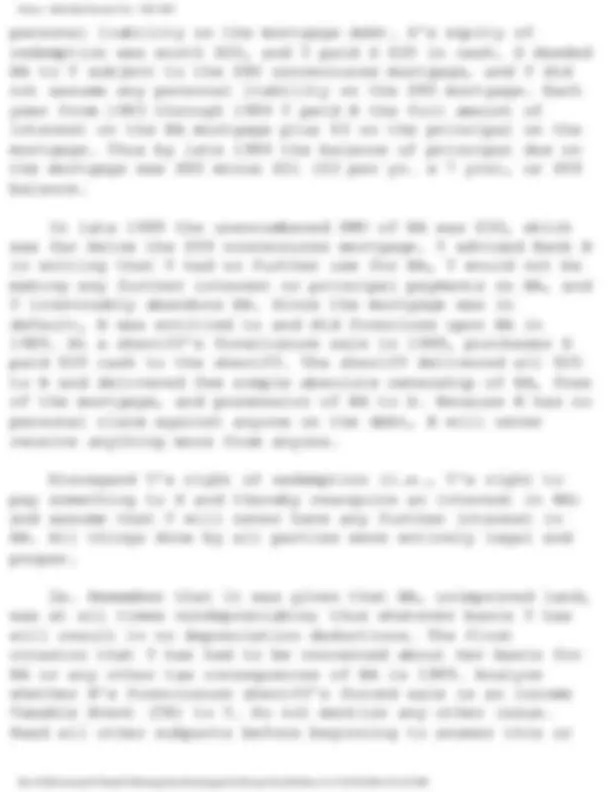
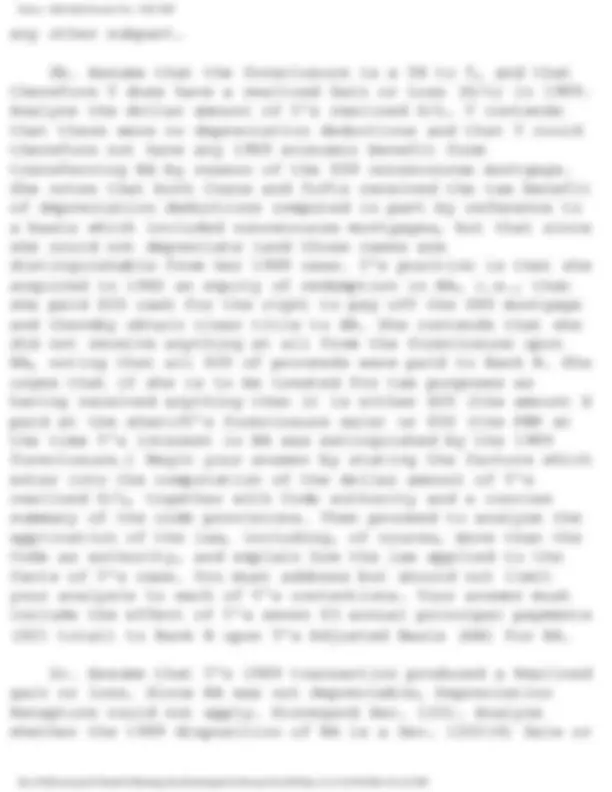
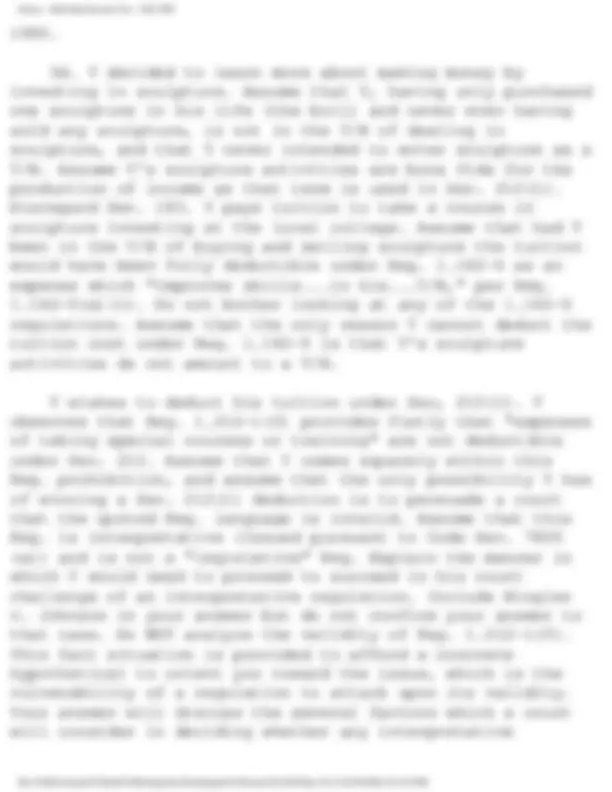
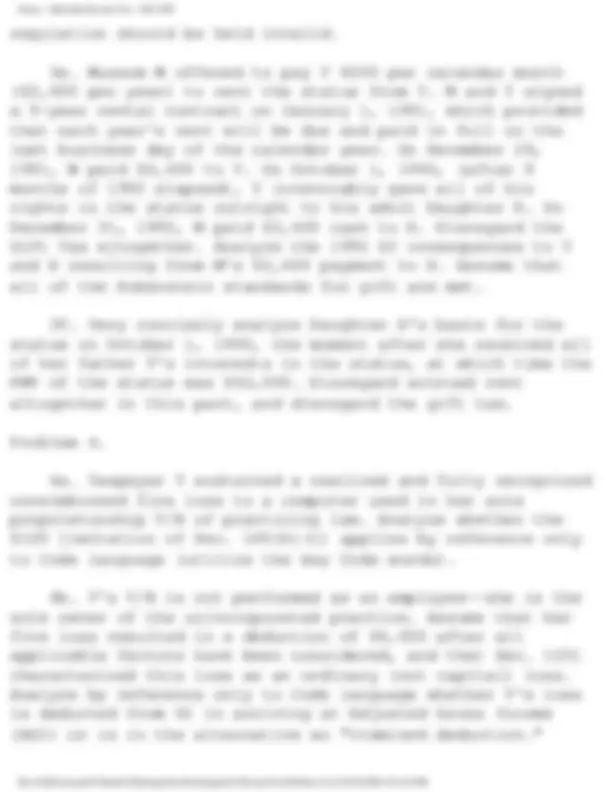
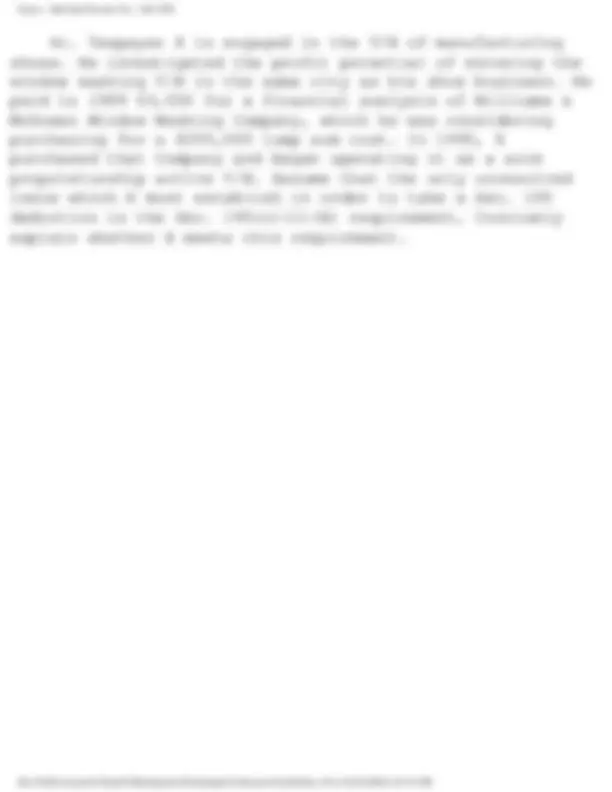


Study with the several resources on Docsity

Earn points by helping other students or get them with a premium plan


Prepare for your exams
Study with the several resources on Docsity

Earn points to download
Earn points by helping other students or get them with a premium plan
Community
Ask the community for help and clear up your study doubts
Discover the best universities in your country according to Docsity users
Free resources
Download our free guides on studying techniques, anxiety management strategies, and thesis advice from Docsity tutors
E Dale Searcy, University of Dayton (OH), Law, Individual Income Tax, Exam Fall 1989, Law Clerk,bona fide,cash,liability promissory note,Fair Market Value,nondepreciable Corvette car,Attorney,significance,pay,transfer,mortgage,interest,foreclosure,Adjusted Basis,inventory,Famous Sculptor,Art Expert,AE,valuable,taxpayer,requirement.
Typology: Exams
1 / 10

This page cannot be seen from the preview
Don't miss anything!







Searcy
INDIVIDUAL INCOME TAX Fall 1989
Problem 1
Law Clerk LC in a bona fide loan borrowed $15,000 cash from his Uncle U in 1987, and in return, LC delivered to U LC's personal liability promissory note for $15,000. Assume that an appropriate rate of interest is specified in the note and disregard all tax aspects of interest throughout this problem. Because LC does not have a good reputation for paying his debts, the 1987 Fair Market Value (FMV) of LC's note is $12,000. Assume that no aspect of any subpart of this problem involves a gift, and that Secs. 102 and 1015 are altogether inapplicable. Disregard Sec. 83 and Sec. 1031 and all other nonrecognition rules throughout all parts of
this problem.
la. Analyze the dollar amount of LC's 1987 GI resulting from the $15,000 loan proceeds which LC received from U. You
must address the $12,000 FMV of the note.
1b. During 1988, LC performed legal research work for Attorney A for an agreed compensation of $9,000. In 1983, A paid $20,000 for a new nondepreciable Corvette car, which A used exclusively for personal purposes; A's Adjusted Basis (AB) for the car was $20,000 at all times until A disposed of the car. In late 1988, when the car had a FMV of $9,000, A offered to transfer the car to LC if LC would accept the car in full payment of the $9,000 conpensation which A owed LC. LC refused the offer, saying that he had no use or desire for a car. Assume that applicable law provides that compensation for services shall be paid in cash, and that LC was for that reason legally justified in refusing to accept the Car. Assume that any compensation that LC receives from A is includible in LC's Sec. 61(a)(1) GI. Analyze the dollar
amount of LC's 1988 GI; you must include constructive receipt in your answer, and explain the significance of A's $20,000 cost and AB for the car.
1c. Assume that any compensation that A pays to LC is fully deductible by A under Sec. 162(a)(1). Analyze the dollar amount of A's 1988 Sec. 162(a) (1) compensation deduction; you must include constructive payment in your answer, and explain the significance of A's $20,000 cost and AB for the car. Remember that this is a Sec. 162(a) (1) only
question; Sec. 165 consequences are not in issue.
1d. Assume that in part b the constructive receipt doctrine did apply to require LC to include $9,000 in 1988 GI. In early 1989, LC changed his mind and agreed to accept the car from A and in return to cancel his $9,000 claim against A. A transferred the Corvette to LC in 1989, when its FMV was still $9,000. Analyze the amount of LC's 1989 Sec. 6l(a)(1) compensation GI by reason of receiving the
car.
1e. In 1990, the Corvette became a collector's item and rose in FMV to $12,000. LC at all times drove the car for personal purposes only. Third party X offered LC $12, cash for the car in 1990, but LC refused the offer. Analyze whether LC has a 1990 Taxable Event (TE) giving rise to Realized Gain or Loss. Do not analyze the dollar amount of any G/LR; confine your answer to the TE issue. You must
include constructive receipt analysis in your answer.
1f. Assume that there was no TE to LC in part e in 1990. In 1991, the FMV of LC's car rose to $15,000. LC had been paying interest but not principal to U each year, so the outstanding balance on LC's debt to U was $15,000 in 1991. LC agreed with U that LC would transfer his car (FMV $15,000) to U in return for U cancelling LC's $15,000 debt; LC transferred the car, and U cancelled the debt in 1991.
personal liability on the mortgage debt. S's equity of redemption was worth $20, and T paid S $20 in cash. S deeded BA to T subject to the $80 nonrecourse mortgage, and T did not assume any personal liability on the $80 mortgage. Each year from 1983 through 1989 T paid B the full amount of interest on the BA mortgage plus $3 on the principal on the mortgage. Thus by late 1989 the balance of principal due on the mortgage was $80 minus $21 ($3 per yr. x 7 yrs), or $ balance.
In late 1989 the unencumbered FMV of BA was $30, which was far below the $59 nonrecourse mortgage. T advised Bank B in writing that T had no further use for BA, T would not be making any further interest or principal payments on BA, and T irrevocably abandons BA. Since the mortgage was in default, B was entitled to and did foreclose upon BA in
Disregard T's right of redemption (i.e., T's right to pay something to X and thereby reacquire an interest in BA) and assume that T will never have any further interest in BA. All things done by all parties were entirely legal and
proper.
2a. Remember that it was given that BA, unimproved land, was at all times nondepreciable; thus whatever basis T has will result in no depreciation deductions. The first occasion that T has had to be concerned about her basis for BA or any other tax consequences of BA is 1989. Analyze whether B's foreclosure sheriff's forced sale is an income Taxable Event (TE) to T. Do not mention any other issue. Read all other subparts before beginning to answer this or
any other subpart.
2b. Assume that the foreclosure is a TE to T, and that therefore T does have a realized Gain or Loss (G/L) in 1989. Analyze the dollar amount of T's realized G/L. T contends that there were no depreciation deductions and that T could therefore not have any 1989 economic benefit from transferring BA by reason of the $59 nonrecourse mortgage. She notes that both Crane and Tufts received the tax benefit of depreciation deductions computed in part by reference to a basis which included nonrecourse mortgages, but that since she could not depreciate land those cases are distinguishable from her 1989 case. T's position is that she acquired in 1982 an equity of redemption in BA, i.e., that she paid $20 cash for the right to pay off the $80 mortgage and thereby obtain clear title to BA. She contends that she did not receive anything at all from the foreclosure upon BA, noting that all $25 of proceeds were paid to Bank B. She urges that if she is to be treated for tax purposes as having received anything then it is either $25 (the amount X paid at the sheriff's foreclosure sale) or $30 (the FMV at the time T's interest in BA was extinguished by the 1989 foreclosure.) Begin your answer by stating the factors which enter into the computation of the dollar amount of T's realized G/L, together with Code authority and a concise summary of the code provisions. Then proceed to analyze the application of the law, including, of course, more than the Code as authority, and explain how the law applied to the facts of T's case. You must address but should not limit your analysis to each of T's contentions. Your answer must include the effect of T's seven $3 annual principal payments
($21 total) to Bank B upon T's Adjusted Basis (AB) for BA.
2c. Assume that T's 1989 transaction produced a Realized gain or loss. Since BA was not depreciable, Depreciation Recapture could not apply. Disregard Sec. 1231. Analyze whether the 1989 disposition of BA is a Sec. 1222(4) Sale or
nondepreciable.
3a. Analyze T's 1989 GI resulting from his purchase for $10,000 of a bull statue with a FMV of $25,000.
3b. The statue was made of stone which was painted with a shiny black laquer. Art Expert AE advised T that sculptures made by FS are much more valuable in their natural granite than when painted. AE cautioned T that it may be impossible to remove all traces of the laquer paint, and if any visible trace remains then the statue might just as well be repainted. However, if all visible traces of the paint are successfully removed, the FMV of the bull will be increased by $15,000 to $40,000. The paint removal must be done by a master craftsman in order to maximize the chance that all traces will be removed and minimize the chance that the statue's surface will be damaged in the process. T paid Master Craftsman MC $8,000 cash in 1989 to remove the paint, with the understanding that MC would do his best but MC does not guarantee that he will succeed in removing all traces of the paint, and that MC retains the $8,000 whether or not the paint removal is complete. MC worked diligently in 1989 and succeeded in completely removing all visible traces of the paint. The statue immediately rose in MV to $40,000. Analyze the 1989 deductibility of the 1989 $8,000 payment under Sec. 162(a) and Sec. 212(1) and Sec. 212(2), and the proper tax treatment of the $8,000.
3c. T anticipated that the bull would rise in value in future years, and planned to keep it until he can make a larger profit from it. On January 1, 1990, T paid $4, cash for a four year insurance policy; in the event that the statue is stolen, vandalized, or accidentally broken the insurance company will reimburse T. Assume that expenses for this type of insurance are deductible under Sec, 212(2) for taxpayers in T's position. Analyze the dollar amount of insurance premium which cash method taxpayer T may deduct in
3d. T decided to learn more about making money by investing in sculpture. Assume that T, having only purchased one sculpture in his life (the bull) and never even having sold any sculpture, is not in the T/B of dealing in sculpture, and that T never intended to enter sculpture as a T/B. Assume T's sculpture activities are bona fide for the production of income as that term is used in Sec. 212(1). Disregard Sec. 183. T pays tuition to take a course in sculpture investing at the local college. Assume that had T been in the T/B of buying and selling sculpture the tuition would have been fully deductible under Reg. 1.162-5 as an expense which "improves skills...in his...T/B," per Reg. 1.162-5(a)(1). Do not bother looking at any of the 1.162- regulations. Assume that the only reason T cannot deduct the tuition cost under Reg. 1.162-5 is that T's sculpture activities do not amount to a T/B.
T wishes to deduct his tuition under Sec, 212(1). T observes that Reg. 1.212-l(f) provides flatly that "expenses of taking special courses or training" are not deductible under Sec. 212. Assume that T comes squarely within this Reg. prohibition, and assume that the only possibility T has of winning a Sec. 212(1) deduction is to persuade a court that the quoted Reg. language is invalid. Assume that this Reg. is interpretative (Issued pursuant to Code Sec. 7805 (a)) and is not a "legislative" Reg. Explain the manner in which T would need to proceed to succeed in his court challenge of an interpretative regulation. Include Bingler v. Johnson in your answer but do not confine your answer to that case. Do NOT analyze the validity of Reg. 1.212-l(f). This fact situation is provided to afford a concrete hypothetical to orient you toward the issue, which is the vulnerability of a regulation to attack upon its validity. Your answer will discuss the several factors which a court will consider in deciding whether any interpretative
4c. Taxpayer X is engaged in the T/B of manufacturing shoes. He investigated the profit potential of entering the window washing T/B in the same city as his shoe business. He paid in 1989 $3,000 for a financial analysis of Williams & McGowan Window Washing Company, which he was considering purchasing for a $200,000 lump sum cost. In 1990, X purchased that Company and began operating it as a sole proprietorship active T/B. Assume that the only unresolved issue which X must establish in order to take a Sec. 195 deduction is the Sec. 195(c)(l)(B) requirement, Concisely explain whether X meets this requirement.